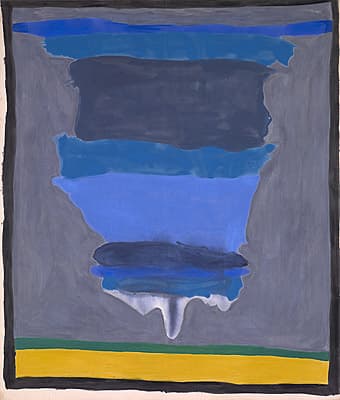
Helen
FRANKENTHALER
United States of America
1928
–
2011
Cape (Provincetown)
1964
synthetic polymer paint and resin on canvas
278.5 (h)
x 237.2 (w)
cm
Purchased with the assistance of the National Gallery Society of Victoria, 1967, National Gallery of Victoria, Melbourne
- the artist;
- with Andrew Emerich Gallery, New York;
- from whom bought, with the assistance of the National Gallery Society of Victoria, by the National Gallery of Victoria, Melbourne, 1967
- Two decades of American painting
- The National Museum of Western Art 15 Oct 1966 – 27 Nov 1966
- The National Museum of Modern Art, Kyoto 10 Dec 1966 – 22 Jan 1967
- Lalit Kala Gallery, New Delhi 28 Mar 1967 – 30 Apr 1967
- National Gallery of Victoria 06 Jun 1967 – 09 Jul 1967
- Art Gallery of New South Wales 26 Jul 1967 – 20 Aug 1967
- Abstract Expressionism: the National Gallery of Australia celebrates the centenaries of Jackson Pollock and Morris Louis
- 14 Jul 2012 – 24 Feb 2013
After her innovative staining technique attracted notice in the early 1950s, Frankenthaler began to experiment again late in the decade. The critic Clement Greenberg had taken Kenneth Noland and Morris Louis to visit her studio in 1953 to witness her strategy on bleeding paint into the canvas. In the late 1950s Frankenthaler began to use synthetic polymer paint rather than oil, and adopted more chance tactics, such as the drips used by Jackson Pollock. She also looked to the suffused colour of Mark Rothko to produce similarly saturated canvases, although to different emotional effect.
The National Gallery of Victoria’s painting, Cape (Provincetown) 1964, plays with ideas about framing and landscape. The title refers to the holiday destination in Massachusetts, a fishing town at the tip of Cape Cod. The blues impart a coastal atmosphere, a marine note that is picked up by bands of yellow and green at the base of the image. Swathes of grass and sand lie below blocks of blues, all contained in black as though within a rough frame. Instead of loose images on the visible weave of the canvas, central patches begin to drip down the picture plane. Nothing is certain here—the imaginary landscape, the sky, the sea. Instead Frankenthaler presents the paint as flat paint, with any narrative elements conjured up by the viewer.
It is difficult to know what effect the artist’s relationship with Robert Motherwell had on her art, or on his; they were married from 1958 to 1971. Both painters began to move away from the highly-emotional gestures of post-war Abstract Expressionism towards a more overall effect. Frankenthaler’s ability to exploit the liquid qualities of paint is notable throughout her long career. The possibly contradictory rejection of the brushmark—so characteristic of Abstract Expressionism—makes her work seem strikingly modern almost 50 years later.
Christine Dixon
Discussion of the work
After her innovative staining technique attracted notice in the early 1950s, Frankenthaler began to experiment again late in the decade. The critic Clement Greenberg had taken Kenneth Noland and Morris Louis to visit her studio in 1953 to witness her strategy on bleeding paint into the canvas. In the late 1950s Frankenthaler began to use synthetic polymer paint rather than oil, and adopted more chance tactics, such as the drips used by Jackson Pollock. She also looked to the suffused colour of Mark Rothko to produce similarly saturated canvases, although to different emotional effect.
The National Gallery of Victoria’s painting, Cape (Provincetown) 1964, plays with ideas about framing and landscape. The title refers to the holiday destination in Massachusetts, a fishing town at the tip of Cape Cod. The blues impart a coastal atmosphere, a marine note that is picked up by bands of yellow and green at the base of the image. Swathes of grass and sand lie below blocks of blues, all contained in black as though within a rough frame. Instead of loose images on the visible weave of the canvas, central patches begin to drip down the picture plane. Nothing is certain here—the imaginary landscape, the sky, the sea. Instead Frankenthaler presents the paint as flat paint, with any narrative elements conjured up by the viewer.
It is difficult to know what effect the artist’s relationship with Robert Motherwell had on her art, or on his; they were married from 1958 to 1971. Both painters began to move away from the highly-emotional gestures of post-war Abstract Expressionism towards a more overall effect. Frankenthaler’s ability to exploit the liquid qualities of paint is notable throughout her long career. The possibly contradictory rejection of the brushmark—so characteristic of Abstract Expressionism—makes her work seem strikingly modern almost 50 years later.
Christine Dixon
